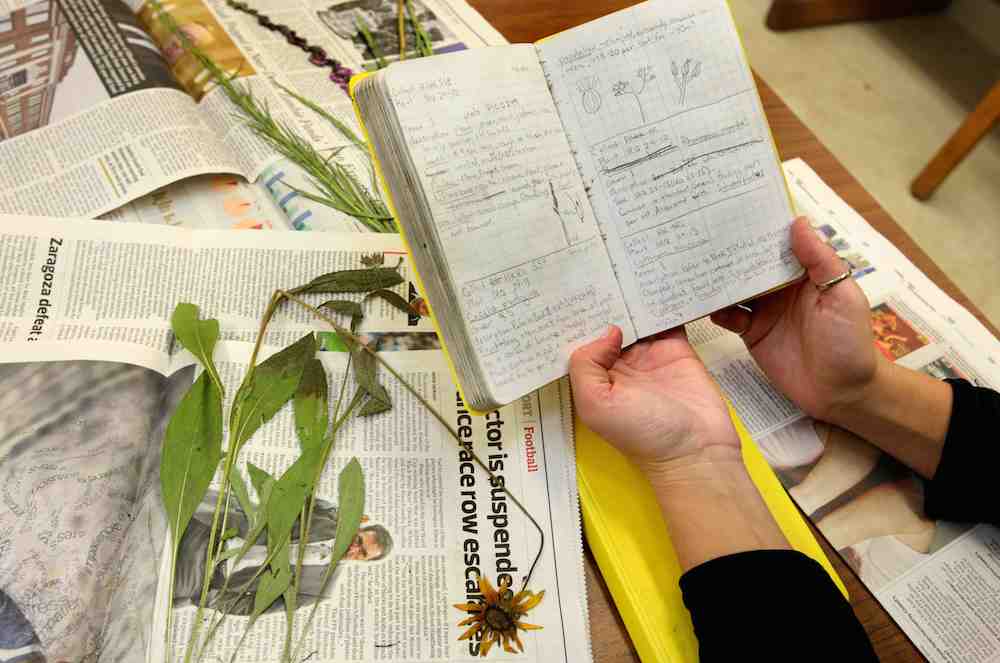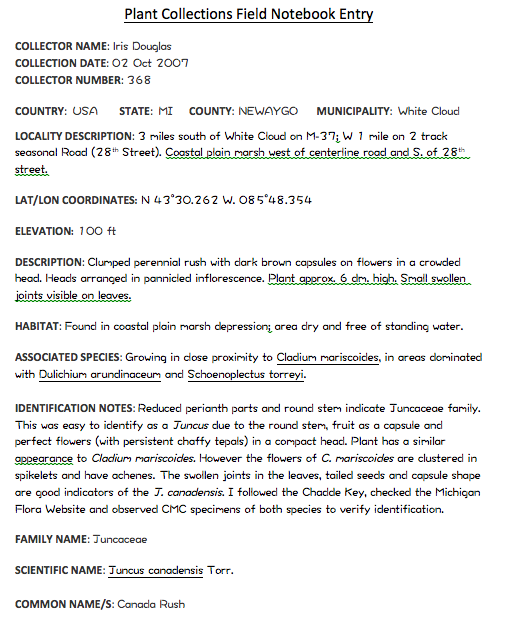IV. Specimen Field Notebook
Lab notebooks and specimen collection are a fundamental part of any plant identification work. Anyone who works in field identification should have a collection notebook with detailed descriptions of the plant localities and habitats where plants are observed so that the sampled plant can be relocated using your specimen as a reference. Every field-collected specimen in the collection is accompanied by a collector’s name and a collection number. If you are just starting your field collection notebook, and you are the collector, then the first collection will be labeled “1”. These numbers will increase the more you collect throughout your lifetime. Once determined, the correct name, authority, and family of the specimen should be written into your field notebook. It is also helpful to include information on how the plant was identified (e.g., the key, monograph or flora used, field guide, internet image search and whether the plant was verified by an authority).
While you will not be graded on your field notebook in this course, maintaining one is necessary to help you accurately remember the information you need to upload to iNaturalist and to write your detailed plant identifications. Here is the information you should include in each field notebook entry, along with general format guidelines:
- COLLECTION DATE: Format should be DD-MMM-YYYY; e.g. "05 Oct 2014."
- COLLECTOR NAME: Format should be first name, middle initial, last name; e.g. "Jonah J. Johnson."
- COLLECTOR NUMBER: Please do not use Roman numerals or prefixes. Begin your field notebook with the number 1.
- COUNTRY, STATE, and COUNTY of collection
- MUNICIPALITY: This is the town or region where you collected, e.g. "Minneapolis."
- LOCALITY DESCRIPTION: Also known as "driving directions," these need to be detailed enough that someone else could retrace your steps to your collecting location. Feel free to use man made landmarks (e.g. roads, street addresses) as well as geographical ones (e.g. rivers, mountains, drainages)
- LAT/LON COORDINATES: If you have a GPS unit, smartphone, or GPS-enabled camera you can record this information in the field. Otherwise, please use Google Maps or another mapping application to add this information later.
- ELEVATION: In meters or feet, but note the units.
- DESCRIPTION: Record features that may not be preserved in the pressed specimen, such as color, odor, sap or latex, height, diameter, etc. Particular attention should be paid to phenology– Is tree in fruit or flower? If so, what color are flowers? You can also describe the plant’s habit–is the plant a tree, shrub, or vine? If you have reason to believe a specimen is cultivated or offspring of a cultivated specimen that has “escaped,” that information should be recorded as such.
- HABITAT: Record anything you know about soil type (sand, clay, loam), topography, slope, exposure, amount of sun, proximity to water sources such as streams or lakes, etc. Describe the site to the best of your ability. You can also include information about the level of disturbance of the habitat, e.g. does the area appear to be naturally forested? In agricultural use?
- ASSOCIATED SPECIES: If you know the identification (even to genus or family) of any other plants growing in the immediate surroundings of your collection, record them here. This information can help researchers assess what type of habitat is present at this location.
- IDENTIFICATION NOTES: Record all methods used for identification. Key characters used in your identification should be listed for family, genus and species. Any close relatives which could be part of a misidentification should be discussed along with distinguishing characteristics.
- FAMILY NAME: Of the plant collected. Be sure to use the most current taxonomy.
- SCIENTIFIC NAME: This includes genus, species, and subspecies or variation if necessary. You may need to take the specimen back to identify in the lab; if so, you will add this information later. Italicize or underline the scientific name.
- AUTHORITY: The name of the botanist who first described this plant. You will find this following the scientific name in any taxonomic identification resource.
- COMMON NAME/S: There may be more than one.
The categories above are included in the blank data entry sheet at the bottom of this page, if you would like to download it as a template. Again, your field notebook data will be the basis of your iNaturalist observations, which will become your specimen labels. Therefore, it is essential to record careful and thorough data for every specimen you collect. Check out the record below for an example...


Field Notebook Template (PDF)